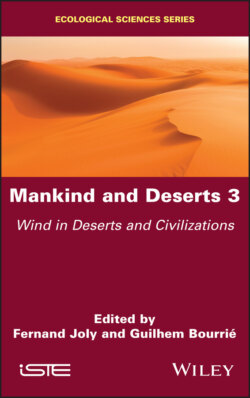Mankind and Deserts 3

Реклама. ООО «ЛитРес», ИНН: 7719571260.
Оглавление
Группа авторов. Mankind and Deserts 3
Table of Contents
List of Illustrations
List of Tables
Guide
Pages
Mankind and Deserts 3. Wind in Deserts and Civilizations
Foreword. Mankind and deserts
Acknowledgments
Introduction: Aeolian Dynamics and Processes
I.1. Conditions and environments in which wind acts. I.1.1. Where is the wind effective?
I.1.2. The environments where wind action occurs
I.1.2.1. “Natural” regions
I.1.2.2. Anthropized environments
I.2. Aeolian processes
I.2.1. Aeolian transport
I.2.1.1. Suspension
I.2.1.2. Saltation
I.2.1.3. Reptation
I.2.1.4. Quantification
I.2.2. Ablation
I.2.2.1. Deflation
I.2.2.2. Corrasion
I.2.3. Accumulation
I.2.4. The combination of processes
I.3. References
1. Aeolian Landforms in Deserts. 1.1. Forms and surface states
1.2. Ablation forms
1.2.1.Desert pavement
1.2.2.Coherent rock landforms
1.2.2.1. Minor forms
1.2.2.2. Yardangs
1.2.2.3. Ridge-Corridor systems
1.2.3. A mixed ablation shape: hydro-aeolian depressions
1.3. Accumulation formations
1.3.1. Amorphous accumulations
1.3.1.1. “Free” sand
1.3.1.2. Sand sheet
1.3.1.3. Nappages
1.3.1.4. Sandbanks
1.3.2.Smaller aeolian formations. 1.3.2.1. Ripples
1.3.2.2. Aeolian formations on obstacles: nabkhas and rebdous
1.3.3.Sandy accumulations without sharp crests
1.3.4.Dunes with sharp crests. 1.3.4.1. Sif – the basic component of dunes with sharp crests
1.3.4.2. Barchans
1.3.4.3. The displacement of barchans
1.3.5.Combinations of sifs
1.3.5.1. Silks
1.3.5.2. Ghourds
1.3.5.3. Aklé
1.3.6.Non-sandy aeolian accumulations
1.3.6.1. Accumulations of “sandy”, non-siliceous material
1.3.6.2. Accumulations of fine material located very close or close by: clayey lunettes and gypseous sandbanks
1.3.6.3. Accumulations of distant fine material: desert loess
1.4. Aeolian systems
1.4.1. Initial combinations: arrow, elb and draa. 1.4.1.1. Sand arrow
1.4.1.2. Elb
1.4.1.3. Draa
1.4.2.Interdune spaces
1.4.3.Polygenic formations
1.4.3.1. Renewed erosion in dune structures
1.4.3.2. Sand Ridges
1.4.3.3. Polygenic systems in regions with prevailing winds
1.4.3.4. Polygenic systems in regions with variable winds: dunes in the NE region of the Grand Erg Occidental
1.5. Ergs, the most complex aeolian systems
1.5.1.Definition
1.5.2. The formation of ergs
1.5.2.1. Localization and extension
1.5.2.2. Typology
1.5.3.From the stability of forms... to a whole new scale: the Grand Erg Occidental
1.6. Conclusion: a new paradigm to explain the organization and orientation of active dunes
1.7. Martian dunes, still mobile…
1.8. References
2. Humans and Winds in Deserts
2.1. Traditional societies and the wind
2.2. The battle against sand encroachment, or the Barrel of the Danaids: the Zouerate railroads (Mauritania)
2.3. The Dust Bowl, the first ecological disaster of the 20th century in a developed country
2.4. The western Algerian Green Barrier, or an error in management. 2.4.1.A “barrier” in an unfavorable physical environment
2.4.2.Difficult implementation
2.4.3.A basic error in understanding aeolian dynamics
2.5. References
3. Living in Deserts
3.1. Humans and the desert. 3.1.1.A “desert civilization”
3.1.2.There are deserts and then there are deserts
3.1.3.The desert, Islam and oil
3.1.4.Antagonistic and complementary civilizations
3.2. Bedouin civilizations. 3.2.1.Nomads
3.2.2. The power of the group
3.2.3.Astonishing knowledge
3.2.4.The fundamentals of pastoralism
3.2.5.Nomad territories
3.2.6.Collective lands
3.2.7.Dromedaries and Bactrian camels
3.2.8.A large-scale ecological transformation: desertification
3.2.9.Social transformation: sedentarization
3.2.10.New forms of pastoralism
3.2.11.The new faces of group structure
3.3. Hydraulic civilization. 3.3.1.Oasis life
3.3.2.The fundamentals of hydraulic civilizations
3.3.3.Water territories
3.3.4.Cradles of hydraulic civilizations
3.3.5.Hydraulic techniques
3.3.6.Collective and individual hydraulic systems
3.3.7. Modes of sharing a rare resource
3.3.8.The diffusion of techniques
3.3.9.Hot deserts and cold deserts
3.3.10.Today: from small wells to deep drilling
3.4. A salt civilization?
3.4.1.Societies in quest of salt
3.4.2.Salt territories
3.4.3.The logistics of salt
3.4.4.An important period in the history of the Sahara
3.4.5. A salt civilization?
3.5. Urban civilizations in the desert. 3.5.1.Cities
3.5.2.The fundamentals of urban life
3.5.3.The city and the road
3.5.4.Networks of urban centers
3.5.5.Capitals under the sun
3.5.6.The city and water
3.5.7. The city and the desert today
3.6. Conclusion
3.7. References
List of Authors
Index. A, B, C
D
E, F
G
H, K, L
M, N, O
R
S
Y, Z
WILEY END USER LICENSE AGREEMENT
Отрывок из книги
Series Editor
.....
Chapter 1 of Volume 3, drafted by Joly, was edited after his demise by Yann Callot, a professor at the University Lyon 2 who is a specialist in ergs and dunes. This chapter examines the importance of wind in the desert. Wind, sometimes considered to be more emblematic of a desert than even dryness, counts among the earliest dynamics on Earth, an element that humans have not always been able to control. Indeed, this lack of understanding of wind has sometimes had disastrous consequences for certain projects (see the Green Dam in Algeria).
The final chapter in Volume 3, “Living in the Desert”, was taken up by Marc Côte, Professor Emeritus at the University of Provence, who worked as a professor for 20 years at the University of Constantine. He has drawn on his deep knowledge of the land and the people of the Saharan region to present what he calls “The Desert Civilization”.
.....